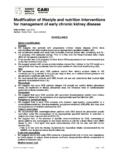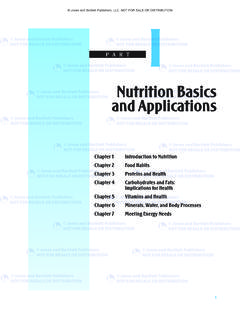Transcription of The workplace as a setting for interventions to improve ...
1 1 The workplace as a setting for interventions to improve diet and promote physical activity1 Background paper prepared for the WHO/WEF Joint Event on Preventing Noncommunicable Diseases in the workplace (Dalian/ China, September 2007) Authors: Lisa Quintiliani Research fellow, Center for Community Based Research, Dana-Farber Cancer Institute Department of Society, Human Development and Health, Harvard School of Public Health Jacob Sattelmair Doctoral student, Department of Epidemiology, Harvard School of Public Health Intern, World Health Organization Global Strategy on Diet, Physical Activity, and Health Glorian Sorensen Director, Center for Community Based Research, Dana-Farber Cancer Institute Professor, Department of Society, Human Development and Health, Harvard School of Public Health 1 This paper is extracted in part from a commissioned paper, prepared by G Sorensen & E Barbeau for the National Institute of Occupational Safety and Health.
2 Steps to a Healthier US Workforce Symposium October 26-28 2004, Washington, DC. Adapted with permission. See and 2 3 World Health Organization 2008 All rights reserved. Publications of the World Health Organization can be obtained from WHO Press, World Health Organization, 20 Avenue Appia, 1211 Geneva 27, Switzerland (tel.: +41 22 791 3264; fax: +41 22 791 4857; e-mail: Requests for permission to reproduce or translate WHO publications whether for sale or for noncommercial distribution should be addressed to WHO Press, at the above address (fax: +41 22 791 4806; e-mail: The designations employed and the presentation of the material in this publication do not imply the expression of any opinion whatsoever on the part of the World Health Organization concerning the legal status of any country, territory, city or area or of its authorities, or concerning the delimitation of its frontiers or boundaries.))
3 Dotted lines on maps represent approximate border lines for which there may not yet be full agreement. The mention of specific companies or of certain manufacturers products does not imply that they are endorsed or recommended by the World Health Organization in preference to others of a similar nature that are not mentioned. Errors and omissions excepted, the names of proprietary products are distinguished by initial capital letters. All reasonable precautions have been taken by the World Health Organization to verify the information contained in this publication. However, the published material is being distributed without warranty of any kind, either expressed or implied. The responsibility for the interpretation and use of the material lies with the reader. In no event shall the World Health Organization be liable for damages arising from its use.
4 The named authors alone are responsible for the views expressed in this publication. 4 Contents Executive summary 4 1. Rationale for using the workplace as a setting for diet and physical activity promotion 5 2. Evidence base for workplace programs targeting diet and physical activity 10 3. Best practices of workplace interventions 11 4. Conclusion 25 Table 1. Health risk reduction through various WHP by significant findings 26 Table 2. Characteristics of best practice programs with examples of diet and physical activity intervention activities 27 5. References 29 5 Executive summary With lifestyle behavioral choices contributing to a significant proportion of chronic diseases globally, evidence-based strategies to improve behavioral risk factors such as healthier eating and regular physical activity should be considered in a variety of settings.
5 The workplace offers several advantages in that a substantial number of the working population can be reached and multiple levels of influence on behavior can be targeted. From the individual-level, for example offering low-fat cooking demonstrations, to the organizational-level, for example paving attractive walking trails around the workplace , workplace health promotion (WHP) programs have been shown through several empirical reviews to have beneficial effects on a range of health outcomes. Several collaborating groups have determined best practices for planning WHP programs, with numerous recommendations overlapping. Linking the WHP activities to organizational objectives, support from top management, and broad-reaching communication programs are important to establish and maintain WHP programs. Incentives, such as gift cards, reduced medical costs, and cash payments encourage employee participation in program activities.
6 Monitoring progress towards program objectives through a built-in evaluation process is needed to ensure that the program can be revised as necessary based on employee feedback. In addition to these practices, there are several guidelines from behavioral science that can guide program activities, such as goal- setting and the motivational stages of change. Importantly, research has shown health behavior decisions are affected by social context in which they are made, such that the social support and social norms surrounding a particular health issue has a substantial impact on how that health behavior is perceived. Finally, building off increasing trends, comprehensive WHP programs integrate health promoting strategies across work organizations including occupational safety and health (OSH), disability management, and employee assistance programs.
7 61. Rationale for using the workplace as a setting for diet and physical activity promotion There is increasing evidence that an unhealthy diet and lack of regular physical activity are related to several adverse health outcomes, such as heart disease , diabetes, stroke, and cancer (1, 2). For example, a landmark review published in 1997 by the World Cancer Research Fund and the American Institute for Cancer Research reported that healthy diets, regular physical activity, and maintaining a normal weight over time could reduce new cancer cases by approximately 30-40% globally (3). Since that time, a second review of these relationships across 17 cancer sites has been completed, which also reported several aspects of diet and physical activity that either directly or indirectly (through their effects on overweight/obesity) has an impact on cancer risk (4).
8 For diet, these include limiting red and processed meats, increasing fruits and vegetables, and moderating alcoholic drinks; for physical activity these include increasing physical activity and reducing total body and abdominal fatness (4). workplace health promotion has generally focused on promoting worker health through reduction of individual risk-related behaviors such as tobacco use, substance use, a sedentary lifestyle, poor nutrition, stressors and reactions to them, reproductive risks, and other preventable health behaviors (5, 6). These efforts have the potential to reach a significant proportion of adults who are employed (7). More specifically, WHP programs are an effective means of promoting a healthy diet and regular physical activity (8-10). Through the workplace , it is possible to influence health behaviors through multiple levels of influence (11); through direct efforts such as health education and increasing the availability of healthy foods and opportunities for physical activity; or indirectly through social support and social norms promoting healthy behaviors.
9 It is also feasible to link worksite health promotion efforts with broader efforts in the workplace to support worker health, such as through occupational health and safety initiatives (12), disability management programs (13) and employee assistance programs (14). Worksites may plan programs with worker input, and may set priorities based on their own assessment of needs, and/or emphasizing those behaviors associated with the largest decrements in mortality and morbidity, increases in disability, decreases in work productivity, or potential for cost savings relative to health impact (1, 15, 16). International initiatives Globally, the majority (80%) of deaths due to chronic diseases are projected to occur in low- and middle-income countries; in these countries, chronic disease mortality also tends to affect younger individuals compared to higher income countries (17).
10 These data underscore the importance of global workplace health promotion and accordingly, the need to adapt the goals of the WHP programs to the local context. For example, WHP planners could consider the availability of health services, literacy levels, and perceptions of good health and quality of life (18). Further examples of considerations and implementation efforts of WHP globally are available (see (17, 18)). The workplace has been internationally recognized as an appropriate setting for health promotion. The importance of workplace health promotion was addressed in 1950 and later updated in a 1995 joint International Labor Organization/World Health Organization (WHO) Session on Occupational Health (19). Since this time, health promotion in the workplace has been broadly recommended by international bodies through numerous charters and declarations, including the 1986 Ottawa Charter for Health Promotion (20), the 1997 Jakarta Declaration on Leading Health Promotion into the 21st Century (21), and the 2005 Bangkok Charter for Health Promotion in a Globalized World (22).

















